Masterpiece Story: L.O.V.E. by Maurizio Cattelan
In the heart of Milan, steps away from the iconic Duomo, Piazza Affari hosts a provocative sculpture by Maurizio Cattelan. Titled...
Lisa Scalone 8 July 2024
Jan Steen’s Woman at Her Toilet is a provocative masterpiece of genre paintings because of its visual complexity and seductive allure, inviting viewers to contemplate the intricacies of everyday life through an intimate lens.
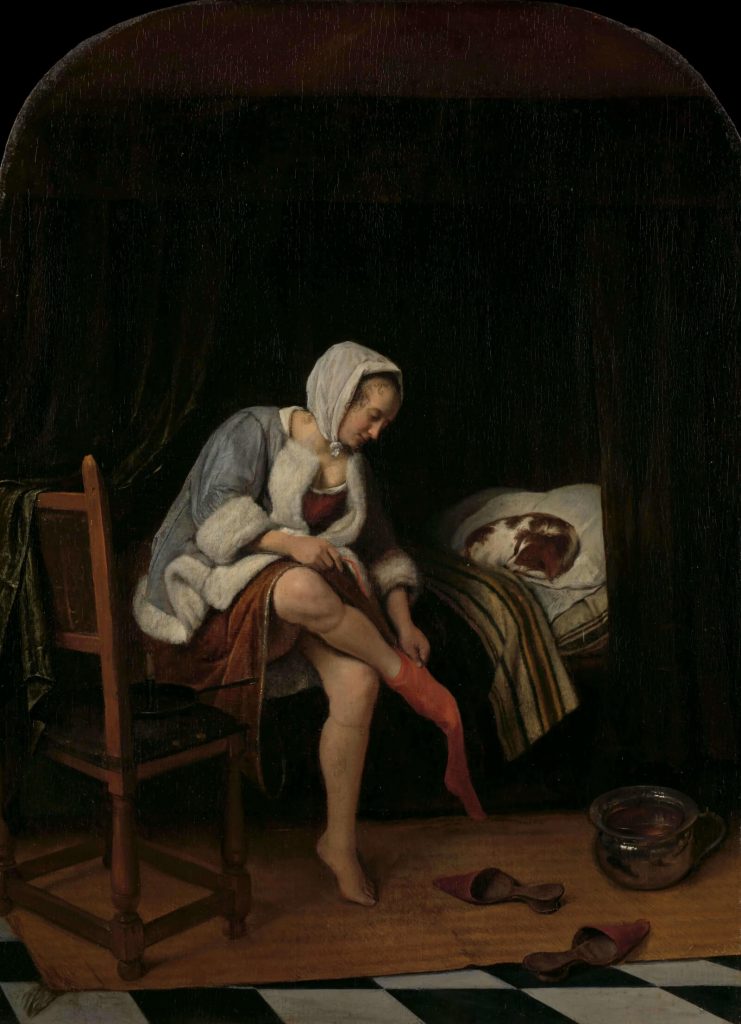
Jan Steen, Woman at Her Toilet, 1655-60, Rijksmuseum, Amsterdam, Netherlands.
Jan Steen lived and worked during the Dutch Golden Age. He is considered a master of interior genre scenes alongside Johannes Vermeer, Gabriël Metsu, and Gerard ter Borch II. Many of his paintings are infused with provocative innuendos that whisper immoral sexuality. Steen’s Woman at Her Toilet is a masterpiece of his sexual genre scenes because of its visual complexity and implied mischief.
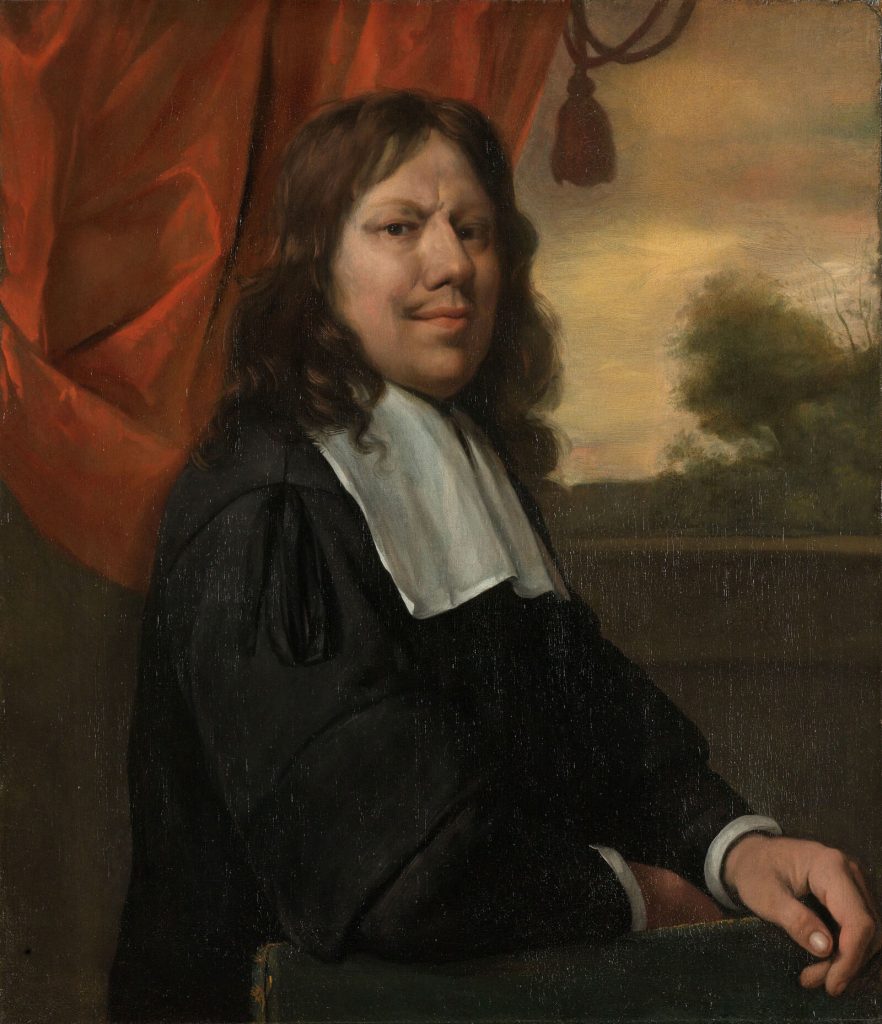
Jan Steen, Self-Portrait, ca. 1670, Rijksmuseum, Amsterdam, Netherlands.
Steen painted Woman at Her Toilet from 1655 to 1660. This 5-year-long creation is an oil on panel that has a portrait orientation and measures 27.5 cm wide and 37 cm high (25.9 in × 21 in). It portrays a young woman sitting on the edge of her alcove bed while she removes a red stocking from her leg. To her left is a chair with a snuffed candle. To her right is a sleeping dog on her pillow. On the floor to her right is a chamber pot and a pair of slippers. A brown rug and a black-and-white checkerboard floor establish the ground while green velvet curtains frame her background. It is an intimate moment that feels both seductive and voyeuristic.
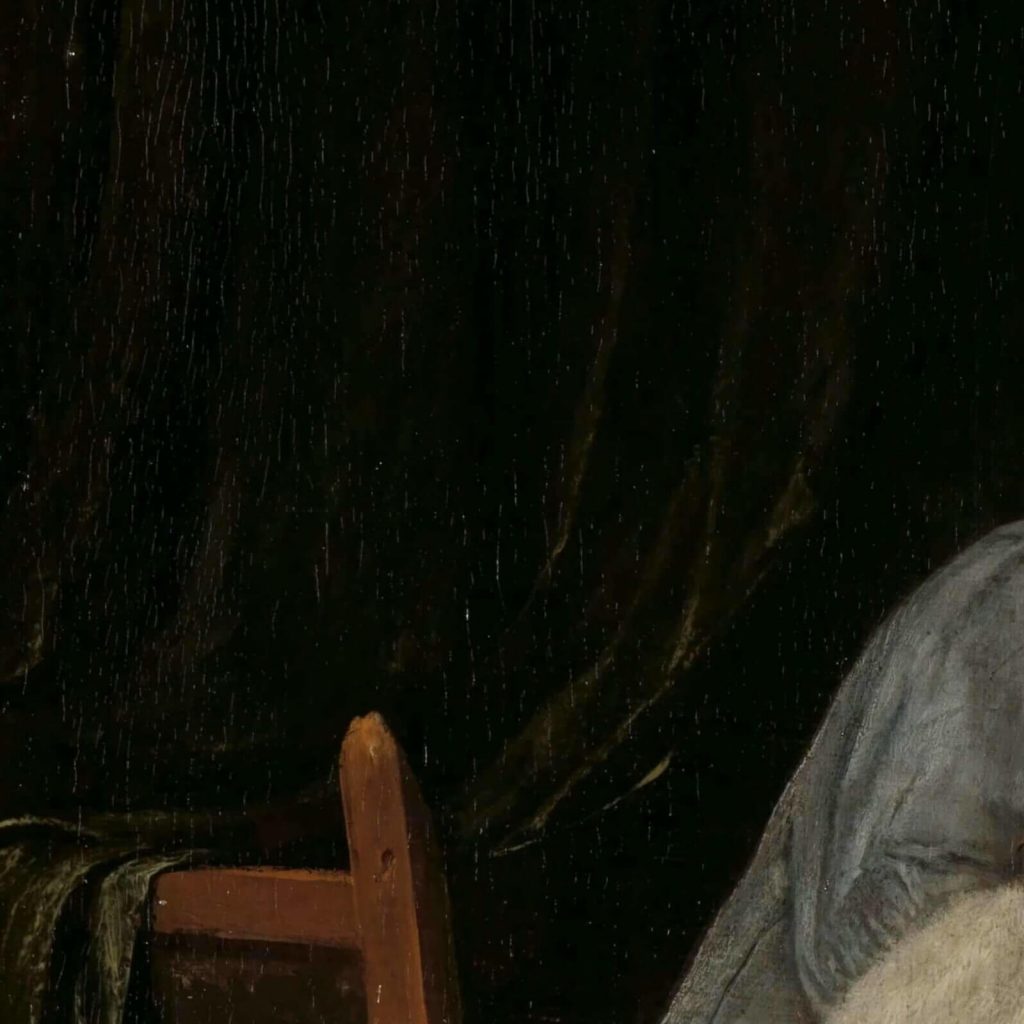
Jan Steen, Woman at Her Toilet, 1655-60, Rijksmuseum, Amsterdam, Netherlands. Detail.
In the center of the painting, and dominating the scene, is a woman slowly undressing. She wears a white cloth headscarf, a fur-trimmed jacket, a burgundy fabric dress, and one scarlet red stocking. She appears to be the epitome of working respectability: not rich but not poor. Simply but properly dressed. Modestly moral.
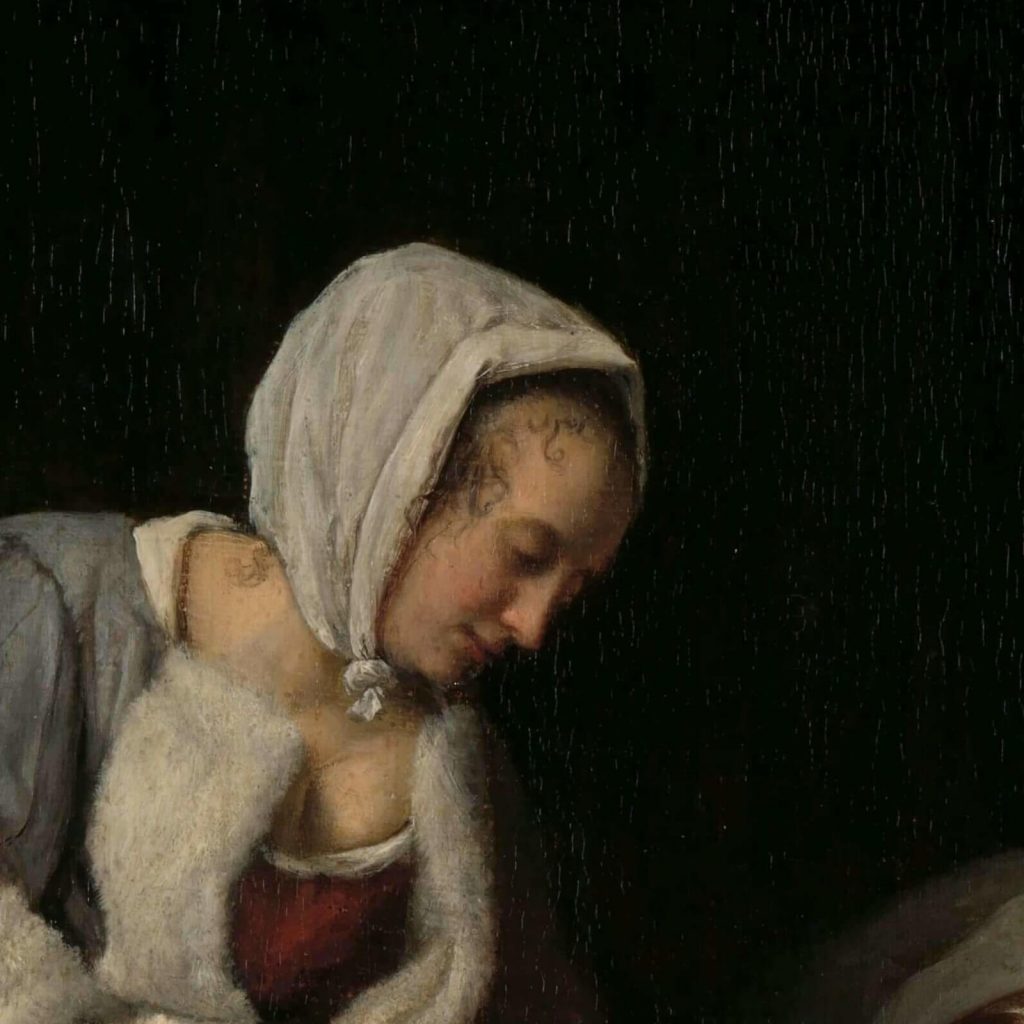
Jan Steen, Woman at Her Toilet, 1655-60, Rijksmuseum, Amsterdam, Netherlands. Detail.
Wrong! The woman is a sex worker. Shock, horror! This simple fact is implied by the red stocking. In the 17th-century Dutch Republic, mostly sex workers wore red stockings. They were the “red lights” of the pre-electric age. A quick flash of a red ankle was a signal to potential clients walking by.
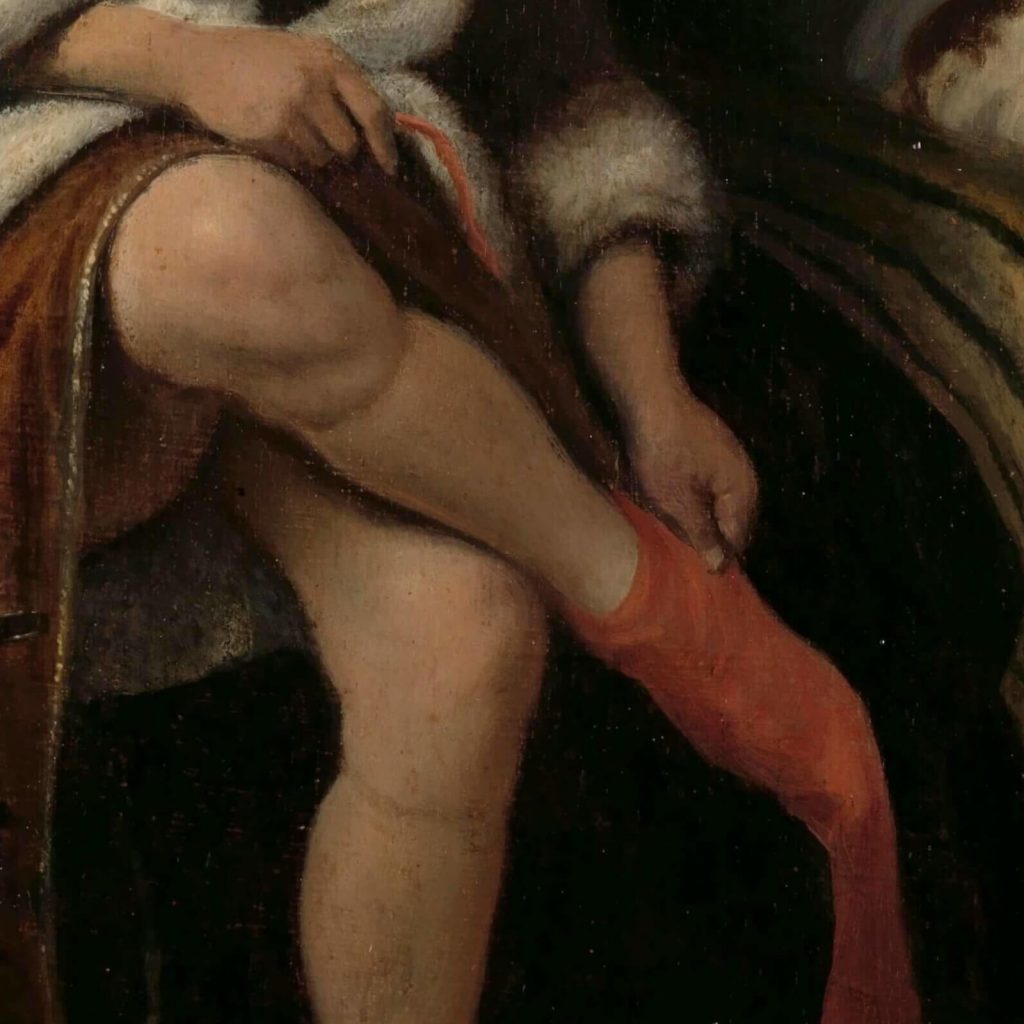
Jan Steen, Woman at Her Toilet, 1655-60, Rijksmuseum, Amsterdam, Netherlands. Detail.
The young prostitute is removing her red stocking after a long day’s work as implied by the indentations of garters below her knees. Her raised skirt reveals her long exposed legs, the underside of her upper thighs, and almost extends to her genital region. It is a sensuous glimpse into the domain of her profession. However, this sensuous peek was not always available because later, during the 19th century, the woman’s legs were painted over with an underskirt. Seemingly Victorian morality demanded a more chaste version and interpretation. Thankfully in the 1920s, the later addition was removed and the painting was restored to its original composition.
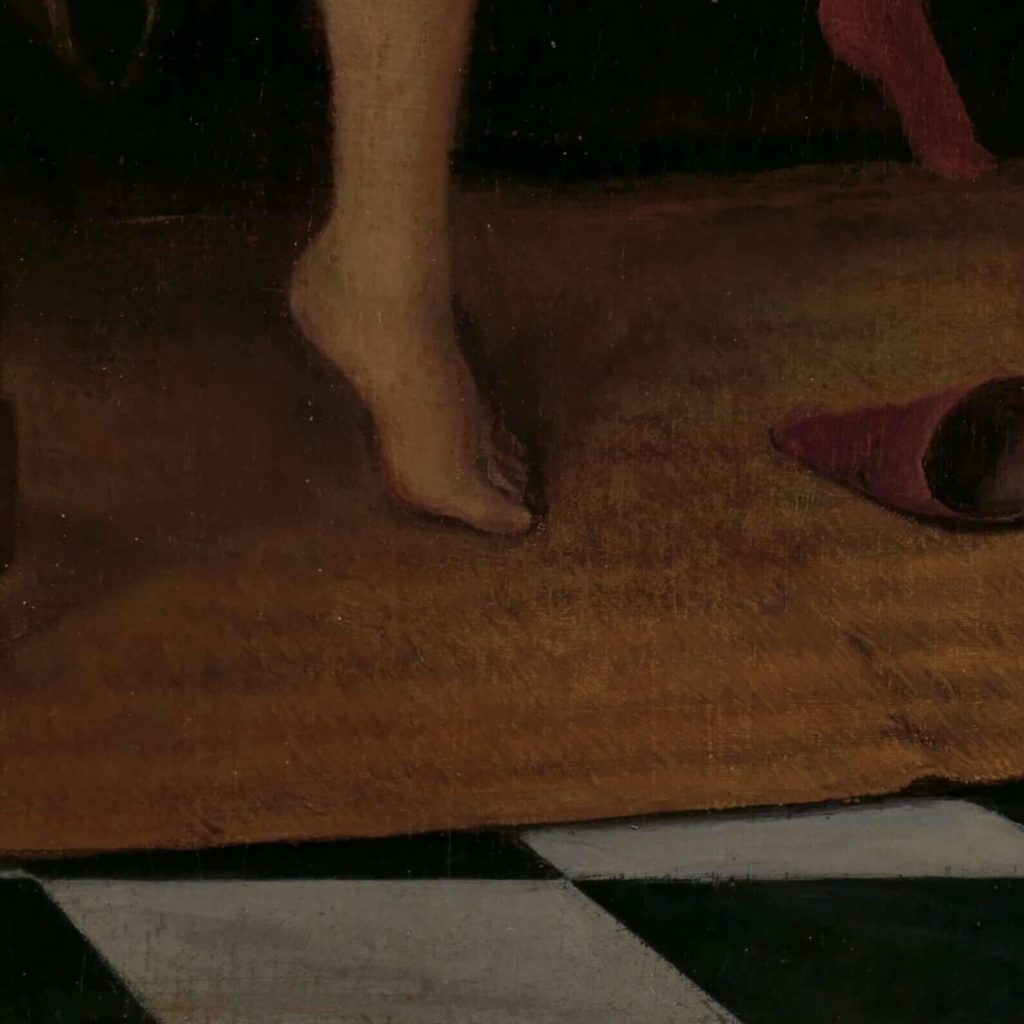
Jan Steen, Woman at Her Toilet, 1655-60, Rijksmuseum, Amsterdam, Netherlands. Detail.
The artist’s creativity goes beyond the visual elements and incorporates wordplay: he utilizes the Dutch term for stocking (kous) as an innuendo for sexual activity, combining the term for chamber pot (piespot) with kous, and forming pieskous—a derogatory term for women in slang.
The model for the composition was Steen’s wife, Margriet van Goyen (1639-69), who was also the daughter of landscape painter Jan van Goyen. However, how could an artist use his respectable wife to model for an unrespectable subject? Simply and easily because Steen enjoyed his wife’s marital sexual flirtations. They were by all accounts a very loving and happy couple. Therefore, she might have even enjoyed posing for her husband-painter. Sexual roleplay is not a contemporary invention; lovers have been roleplaying since recorded history. Therefore, perhaps Jan and Margriet had an artistically sexual giggle together as she pretended to be the sex worker, and he pretended to be the client. Strip away electronic technology and digital connectivity, and modern lovers are still closely similar to the 17th-century Dutch.
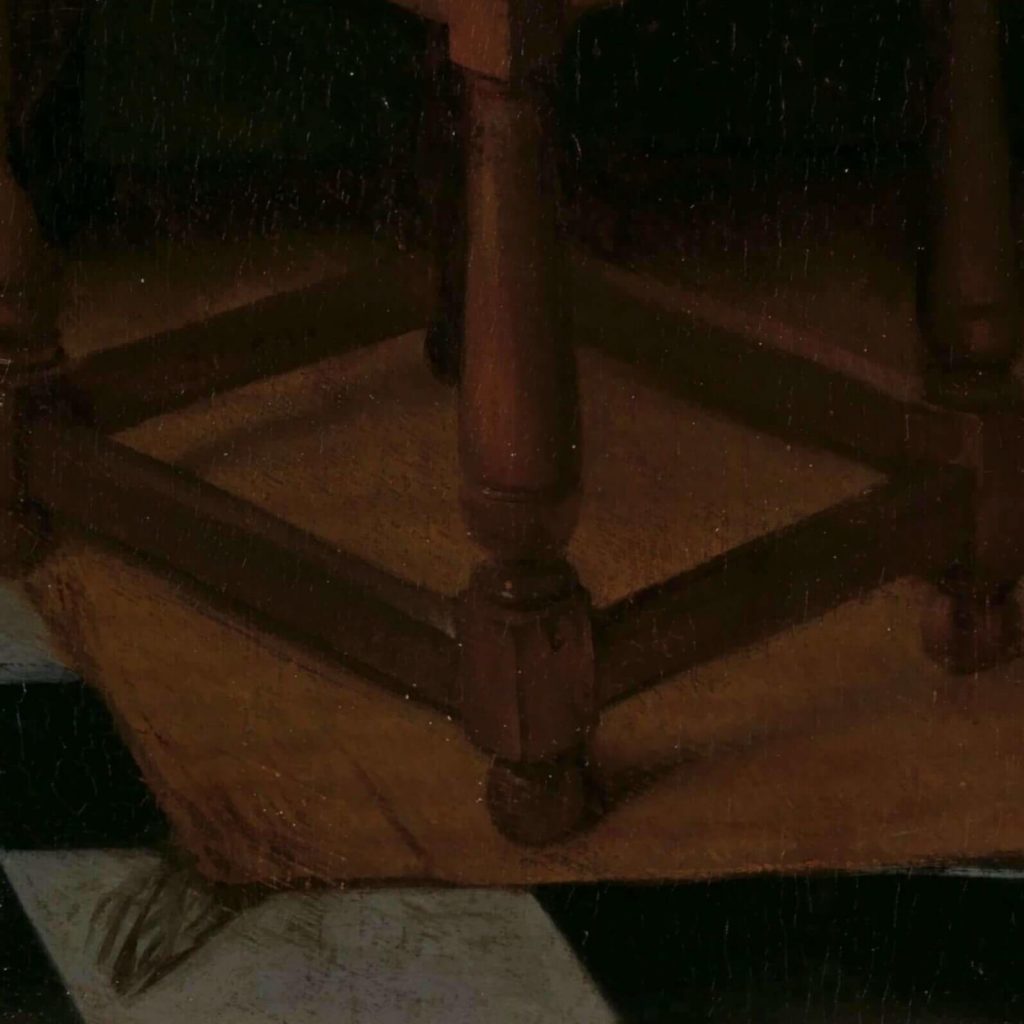
Jan Steen, Woman at Her Toilet, 1655-60, Rijksmuseum, Amsterdam, Netherlands. Detail.
The woman in the painting is at the end of her day. She has said goodbye to her last client and she is ready for bed. The candle sitting on the chair is already extinguished. The slippers have been lazily cast-off and strewn across the floor. The chamberpot is full to the brim with a day’s worth of urine.
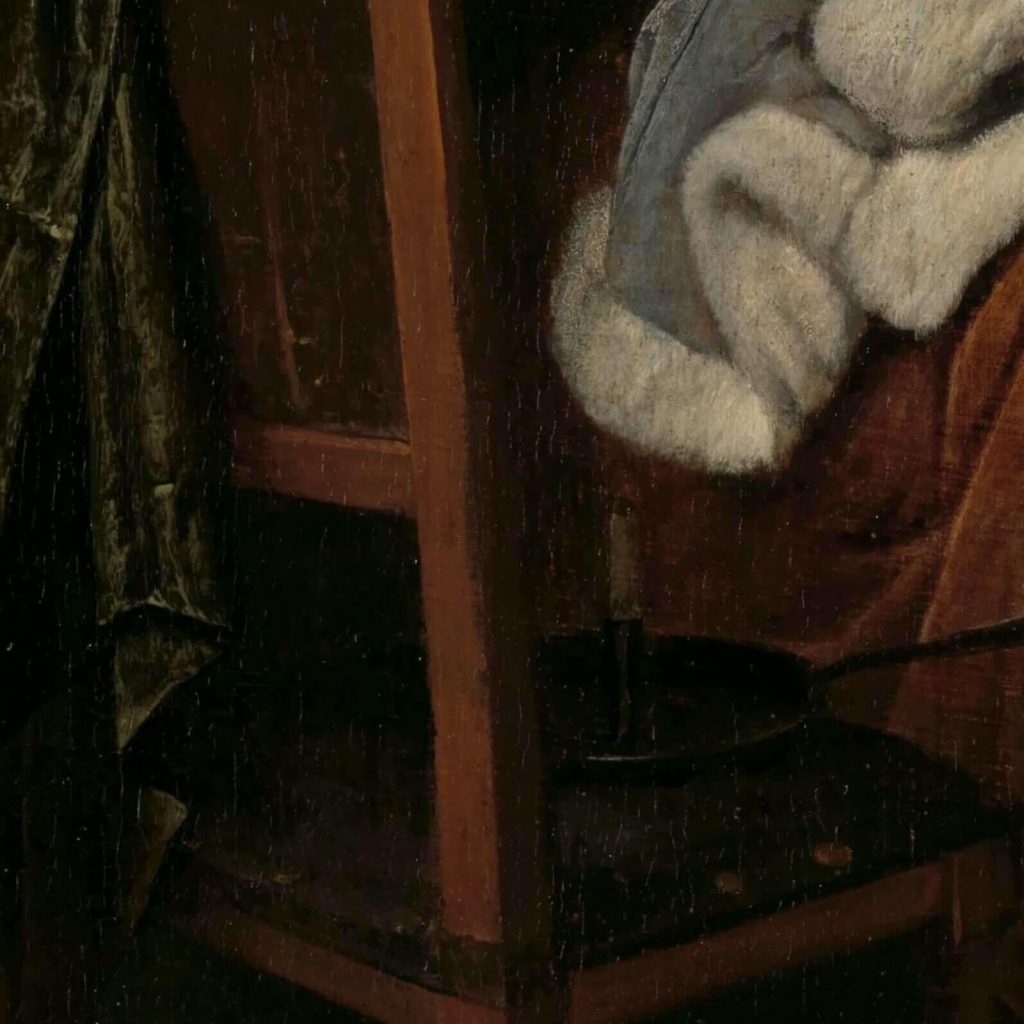
Jan Steen, Woman at Her Toilet, 1655-60, Rijksmuseum, Amsterdam, Netherlands. Detail.
Will the young woman empty her chamberpot before retiring to bed? Probably not. That is a dutiful task to await the morning’s approach when she faces another day of purchased love. For now, she is too tired to care.
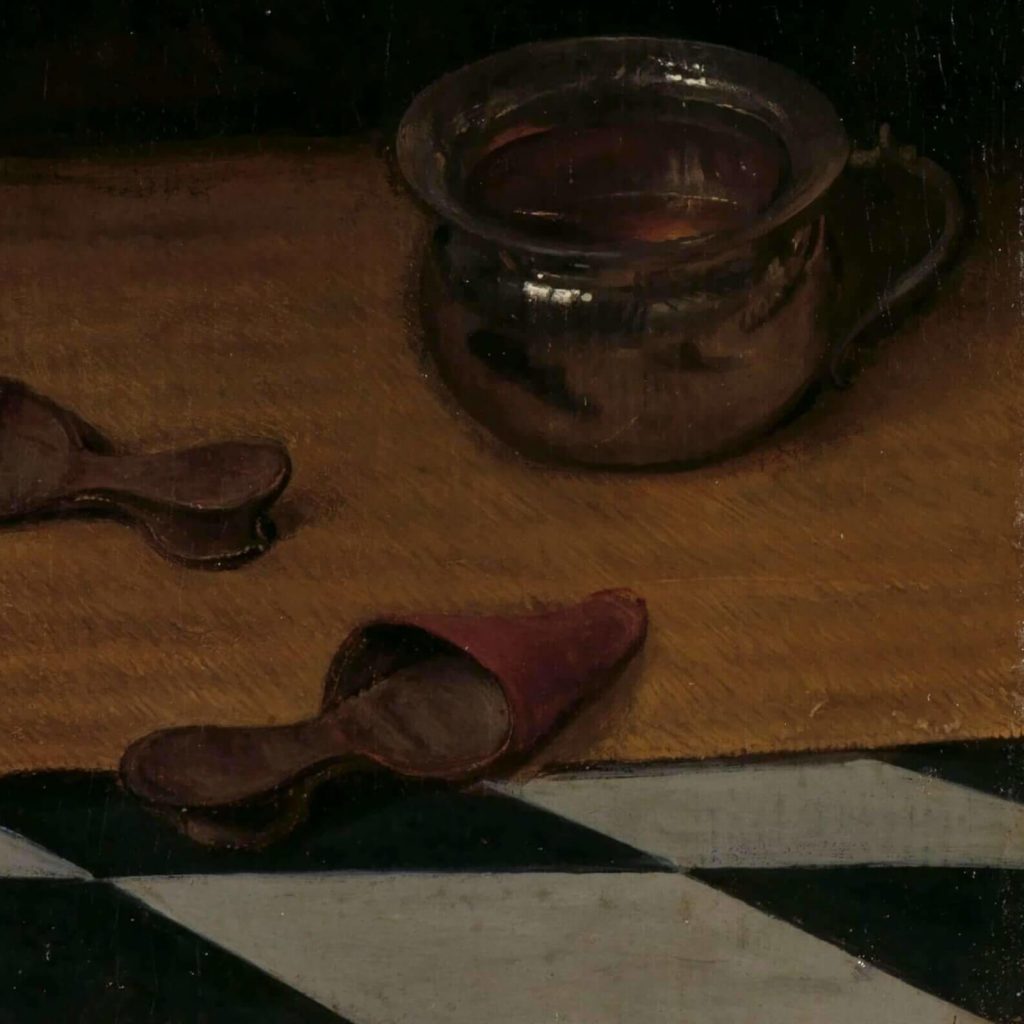
Jan Steen, Woman at Her Toilet, 1655-60, Rijksmuseum, Amsterdam, Netherlands. Detail.
The several fine items within the scene imply that the sex worker is not struggling to find clients because she has achieved a certain level of comfort. Perhaps she has elevated above streetwalking and now has regulars? Or even better, she has found one exclusive rich protector? Whatever her business model, the fur-trimmed jacket, green velvet curtains, and pet dog all imply expendable income. They are not necessities; they are comforts to what could be a very empty existence.
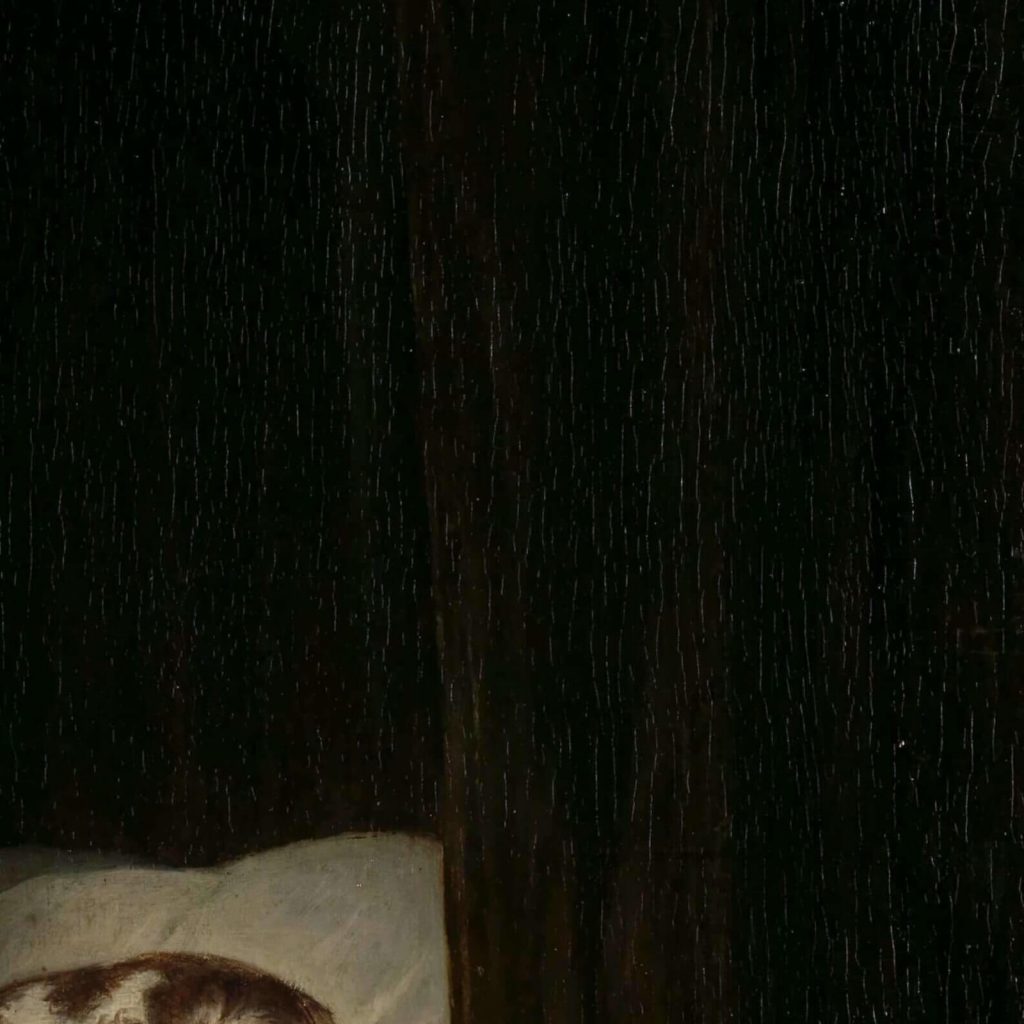
Jan Steen, Woman at Her Toilet, 1655-60, Rijksmuseum, Amsterdam, Netherlands. Detail.
Therefore, Steen asks the viewer to evaluate the scene. Is the young woman a symbol of unapologetic promiscuity, or is she to be pitied as an unfortunate victim of the circumstances of her times? Did this woman actively choose her profession, or was she forcibly pushed into it by environmental factors? Should the viewer admire her physical beauty, scorn her sexual impurity, or pity her emotional captivity? Siren, slut, or sufferer. Which one is it?
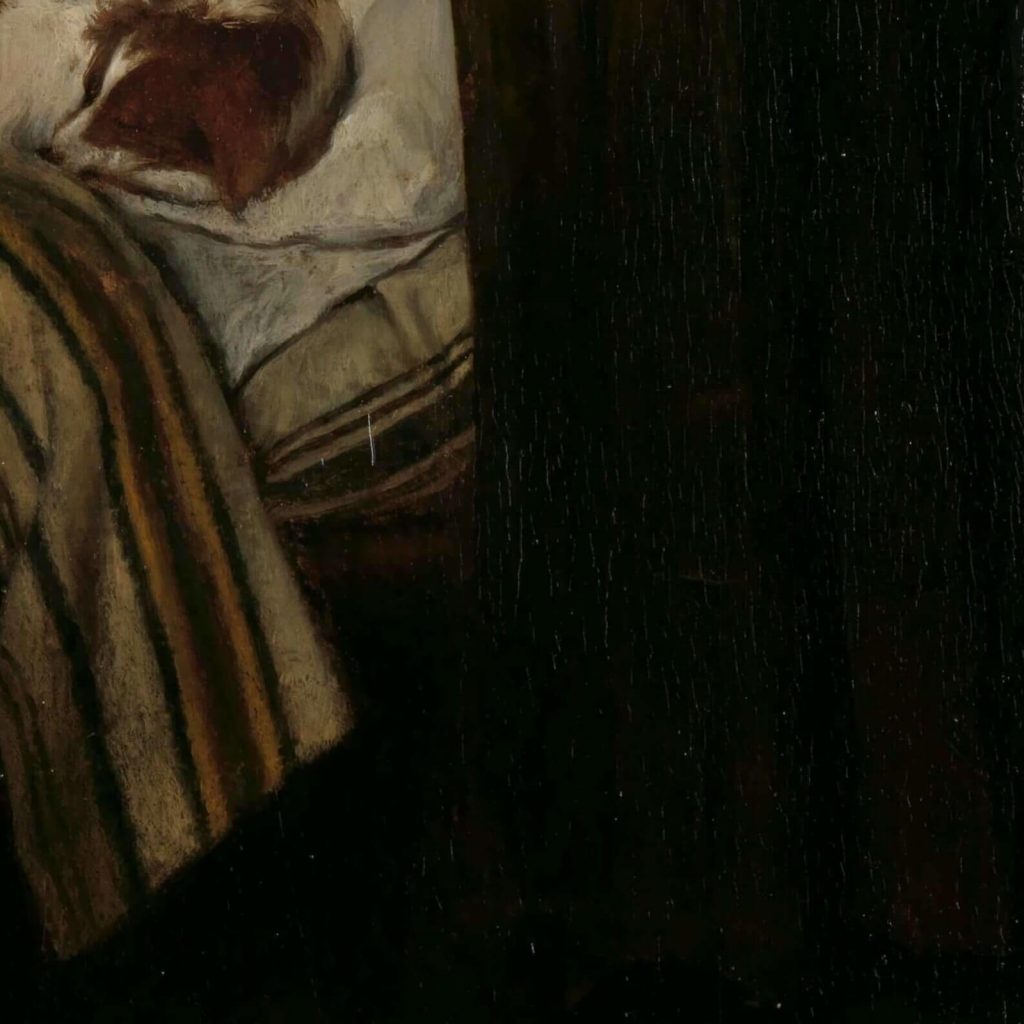
Jan Steen, Woman at Her Toilet, 1655-60, Rijksmuseum, Amsterdam, Netherlands. Detail.
De Girolami Cheney, Liana. “Jan Haicksz Steen’s Woman at Her Toilet: ‘Provocative Innuendos.’” Journal of Literature and Art Studies 7, no. 10 (2017).
“Self-Portrait.” Collection. Rijksmuseum, Amsterdam, Netherlands. Retrieved 15 August 2023.
Waiboer, Adriaan E., Arthur K. Wheelock, and Blaise Ducos. Vermeer and the Masters of Genre Painting. Translated by Caroline Beamish and Diane Webb. New Haven, CT, USA: Yale University Press, 2017.
“Woman at her Toilet.” Collection. Rijksmuseum, Amsterdam, Netherlands. Retrieved 12 August 2023.
DailyArt Magazine needs your support. Every contribution, however big or small, is very valuable for our future. Thanks to it, we will be able to sustain and grow the Magazine. Thank you for your help!